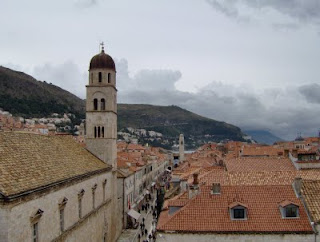November 12, 2009
We arrived in Civitavecchia, Italy about 7:00am this morning. This is where the ship has to dock for Rome. The port has a shuttle bus that you have to take from your ship to the port entrance. From there, you turn right and walk about 10 minutes to the train station (on the opposite side of the street).
We ended up buying BIRG tickets for 9 euros. It was a 5 zone ticket, which allowed us to use it on the train to and from Rome, the Rome metro, as well as the buses.
By car, or tour bus, it takes about 1 1/2 hours to reach Rome from Civitavecchia. By train, about 1 hour, depending on how many stops it makes.
There is so much to see and do in Rome, and only one day, what do you do? Since I've never been to Rome before, I decided that my top three sights were: Vatican Museum & Sistine Chapel, St. Peter's Basilica and the Pantheon.
We purchased tickets for the Vatican museum online, which saved us from having to wait in line. You buy the tickets by date and time. Our time was 10:00am.
We took the train to Termini station and then transferred to the metro. Our guidebook said to get out at the Cipro stop. The metro map said to get out at the Ottaviano stop. We followed the guidebook.
There were signs pointing the way to the Vatican museum, but we got lost at some point. We eventually found the entrance.
The Vatican museum is huge. We decided to follow the signs to the Sistine chapel and see the art that was displayed along the way. We saw the Gallery of the Candelabra (classical sculpture), the Gallery of Tapestries, Gallery of Maps, the Raphael rooms, the Modern Religous Art collection, and then, the Sistine Chapel.
I couldn't believe that I was actually in the Sistine Chapel. We found a spot on the bench by the Last Judgment. The room was packed with lots of tourists. I read the information from the guidebook and looked at each painting. It was overwhelming.
When it was finally time to go, we headed towards the secret exit. We waited until a small group of people used it and we followed them. There was a long staircase and a security guard at the bottom in a glass booth. The other people started down the stairs and then stopped. We continued slowly down, wondering what was going to happen when we reached the guard. Just before we reached the bottom of the staircase, he got a phone call. The exit was to the left. Just as we reached the door to leave I heard a click. I thought, "Oh no, we're locked in! We're in trouble!" I reached my hand out to the door handle and tried it. It opened! The guard had unlocked the door for us!
This secret exit takes you directly into St. Peter's Basilica. We avoided a long walk back to the entrance of the Vatican Museum, another long walk to St. Peter's, and the long security check lines for the Basilica.

Another "wow" moment, standing inside St. Peter's Basilica. I've been inside several cathedrals throughout France and Italy, but none of them compare to this one! The dome itself is 430 feet from the floor of the cathedral to the top of the lantern. The baldacchino (bronze canopy) is about seven-stories tall.

Michelangelo's Pieta statue of Mary holding the dead body of Christ was an impressive sight as well. It was behind a shield of bulletproof glass.

We went outside the basilica to St. Peter's Square. We were tired from so much walking, so we sat in the shade of the colonnade and had a snack.
On the way to the Pantheon, we stopped at the Spanish Steps and the Trevi Fountain.

The Pantheon was also a very impressive sight, outside and in!

After visiting the Pantheon, we walked to Piazza Navona. We saw Bernini's Fountain of the Four Rivers.

Then it was time for a gelato break. I had Nutella gelato, yummy! We then decided to take the metro to the Colosseum. We got lost along the way and ended up at Piazza del Popolo.

I thought, "I feel like I'm on an 'Angels and Demons' tour!" We finally found a metro station to go to the Colosseum.

I was surprised at the modern sculptures around the Colosseum. We didn't go inside the Colosseum because we were getting short on time. We could see the Roman Forum in the distance, and the Arch of Constantine.

At this point, I was really tired from the walking and sightseeing. It was also getting close to 4:00pm and we needed to be back on the ship by 7:30pm. We took the metro back to Termini train station, and then a train to Civitavecchia.
What a day! So much to see and so little time! I would like to return to Rome someday and hopefully spend more than one day there.





























































